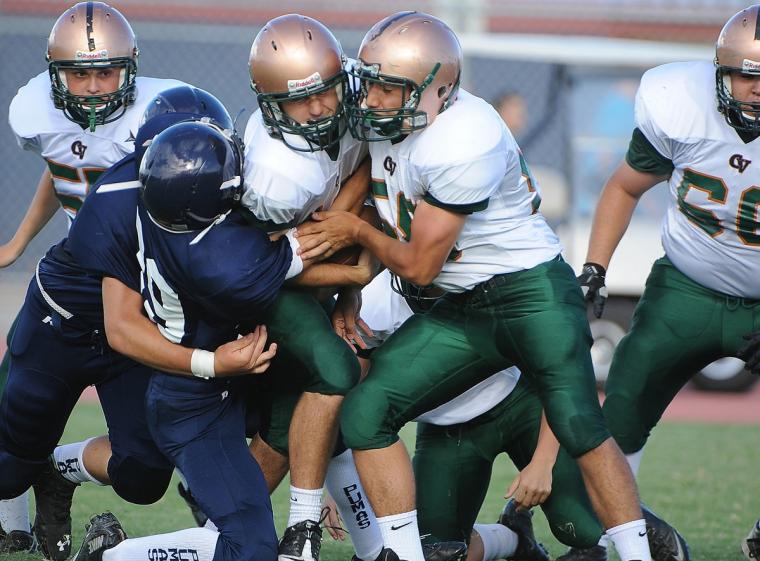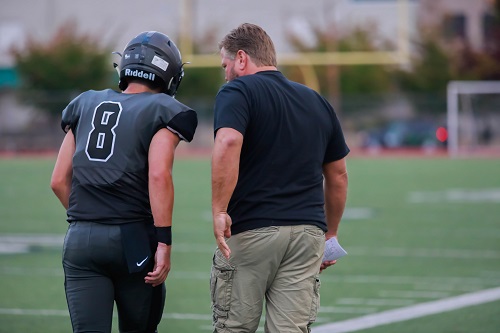
The landscape of amateur sport in the age of NIL has been nothing short of buzzy, and a recent development has made that buzz even louder.
USFL founder and former president Brian Woods has announced that he is launching the Prep Super League, a spring high school football league focused on drawing top recruits (described by Front Office Sports as four-star and five-star level players), with NIL earnings potential among the biggest attraction.
“There has never been a travel or club option — or a supplemental platform, if you will — to traditional high school football,” Woods told reporters at Suncoast News. It is worth noting that Woods also founded The Spring League, a national developmental league (with various scouting showcases) for aspiring pros that existed from 2017-21.
The Prep Super League is expected to take the field next spring. According to Front Office Sports, the format will be 11-on-11, and will have 12 teams. It will run from April 19 to May 24 with teams based in Atlanta, Cleveland, Dallas, Houston, New Jersey, New Orleans, Los Angeles, Miami, Phoenix, San Diego, San Francisco and Tampa. (In other words, powerhouse states for football.)
But... where is a website for this organization? Run a search for Prep Super League and nothing comes up but news stories. Will it happen? That seems to be up in the air.
According to an Associated Press story quoted in High School Football America, “Woods said his league will use NCAA playing rules and will operate independently of high school state athletic associations, giving players the chance to profit off their name, image and likeness (NIL) without any restrictions.” It will be aimed at rising juniors and rising seniors in high school, not at recent graduates. Woods also told AP that players will be eligible to participate in the league only if they are enrolled in an accredited middle or high school curriculum and live in one of the league’s 12 markets.
Suncoast News adds, “Think of it as the 11-on-11 football equivalent of upper-tier travel baseball or AAU basketball. The initial season would stretch from April 19-May 24. Players likely will be required to pay an entry fee (at least initially). The league will target coaches with college experience, though Woods said he certainly won’t turn his back on veteran prep coaches.”
High school football coaches have been less than enthusiastic about the league, citing a number of concerns. Among them, said Suncoast News, are “the prospect of a teenager playing six more full-contact games (in addition to a full prep schedule in the fall), the overlap of the Prep Super League’s season with high school spring practice (held from early- to mid-May), and the possibility that a coveted prospect could use the Prep Super League’s spring season as his de facto senior year.”
It's not the first time someone has cited elite-level play as a detriment to the high school experience, or to high school programming as a whole. The National Federation of State High School Associations has spoken out in no uncertain terms on the subject and in this article in Medium, a coach accused travel ball of “ruining high school sports.”
Woods is not bothered. He says the experience of playing in the Prep Super League will help top athletes catch the eye of college coaches; in fact, current plans are for players will wear sensors to measure performance metrics that can be shared with college programs or professional leagues. And that could lead to better opportunities.
 But athletic scholarships to college and exposure to pro sports agents have long been the carrot on the end of the stick that pushes parents to enroll their children in travel programs and elite sports teams. In fact, as far back as 2019, a survey by TD Ameritrade found parents were taking second jobs and even going into debt to fund their children’s participation in these programs.
But athletic scholarships to college and exposure to pro sports agents have long been the carrot on the end of the stick that pushes parents to enroll their children in travel programs and elite sports teams. In fact, as far back as 2019, a survey by TD Ameritrade found parents were taking second jobs and even going into debt to fund their children’s participation in these programs.
However, the odds of anyone, no matter how talented, achieving a scholarship, much less making it into the pros or the Olympics, are very low. CBS News in 2012 noted that only about two percent of high school athletes win sports scholarships every year at NCAA colleges and universities. And the average scholarship isn’t that much – about $11,000 – which leaves a lot of money to be made up by parents.
There are only six sports where all the scholarships are full ride. These so-called head-count sports are football, men and women's basketball, and women's gymnastics, volleyball and tennis. In these Division I sports, athletes receive a full ride or no ride. And the TD Ameritrade report found that from 2016 to 2019, the number of sports parents’ children who secured an athletic scholarship has declined by more than half (24 percent in 2016; 11 percent in 2019).
Side note: ouch. Nevertheless, that hasn’t stopped the optimism; 20 percent of sports parents are certain that their child will secure a college athletic scholarship. And somehow, the majority of parents still believe college scholarships will cover more than half of tuition, and one in 10 are optimistic their child will receive a full ride.
The TD Ameritrade survey notes, “Parents are banking on their child receiving a college athletic scholarship as payoff for the investment they have made in their child’s sports. Parents are more confident that their child will receive a college scholarship than a few years ago, though the number who report having children who actually received one has dropped by half since 2016.”
Don’t expect that kind of thing to stop Woods. He also believes his program can do more for player development than many other programs, including camps that are listed as showcase events.
“If you look at 7-on-7, you look at these camps, at the end of the day, none of them are 11-on-11 football,” Woods told reporters at AP. “None of them are going to give a quarterback, for instance, in a 7-on-7 situation, a live pass rush. So, if you’re looking to evaluate players in an actual football context, that’s what this league is about.”
In Chardon, Ohio, football coach Mitch Hewitt said the league could wreak havoc on high school football players’ careers.
“How do you do this from an eligibility standpoint?” he asked reporters at The News-Herald.
And, noted the subsequent article, “That’s a massive question because two OHSAA bylaws would likely be violated by any player participating in such a league. The OHSAA does not allow for tackle football to be played outside of the season, and the OHSAA doesn’t allow student-athletes to make money on their NIL. An NIL measure failed by member school vote, 538-254, last year.”
The article continued:
“It’d have to start with the OHSAA, because (participants) would be deemed ineligible,” another local high school coach, Matt Duffy, told reporters. “Any kid that participates in a league at any time (besides the scheduled season) is deemed ineligible the following year. The OHSAA would have to change its bylaws.”
Even if the bylaws were changed, Duffy isn’t sold on it being a good idea. Mentor coach Matt Gray agreed.
“If you ask a kid to play 10-16 football games in the fall, then play an X-amount of games in the spring, that’s not good nor is it in the best interests of the young men,” said Gray.
Count Kirtland coach Tiger LaVerde is a skeptic, also.
“Our sport is too physical to play year-round like AAU basketball,” he said. “Sounds like someone is trying to make money off it, like all the AAU stuff. I don’t think it’s good for kids.”
Said another high school coach: “The elite don’t need the exposure. If you’re an elite dude and have offers already, are you going to play in this league?”
According to High School Football America’s latest count, 30 states allow NIL for student-athletes.
Provided the Prep Super League gets a website and gets off the ground, SDM will continue to follow this developing issue.

